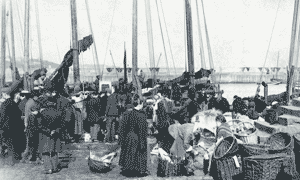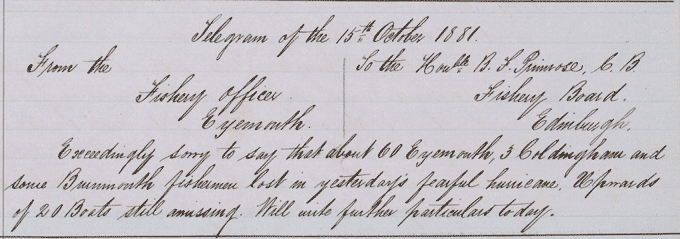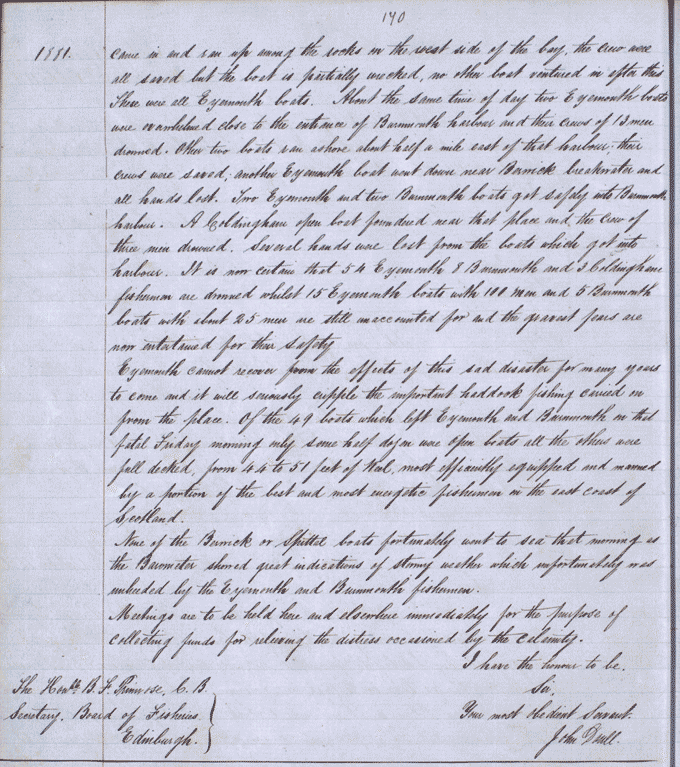The Eyemouth Fishing Disaster, 1881

Scotland is famous for its frequently wet and windy weather. It lies in the path of eastward-moving Atlantic depressions which bring wind and clouds throughout the year, and is frequently hit by windstorms during the autumn and winter.
A severe storm struck the southern coast of Scotland on 14th October 1881, leading to the Eyemouth fishing disaster or ‘Black Friday’ as some locals call it. The Edinburgh Evening News reported the storm on Saturday 15th October:
A storm of extraordinary violence set in on Thursday night and raged for the greater part of yesterday all over the country, causing great distruction to property and loss of life. All telegraphic communication between Scotland and the Metropolis was broken down by the wreckage of the wires and in several parts of the country similar isolation has occurred. Hundreds of magnificent trees have been torn to pieces or uprooted and cast across the roads, rendering traffic impracticable. From all parts of the country floods and serious agricultural havoc are reported. Railway traffic, in consequence of the distruction of signal posts and wires, was carried on with difficulty and the drivers of express trains report that they could scarcely maintain their footing on the engines. Snow lies deep in the north and the lower ranges of the Grampians have also received a coating of snow.
Fishing was an essential part of the local economy in Eyemouth: the men went fishing and the women supported them by baiting the lines and repairing nets. The sudden windstorm in October 1881 blew up while the fishing boats were out at sea and caused the deaths of 189 fishermen, of whom 129 were from Eyemouth itself. Many of the fishing boats capsized; others were wrecked on the rocky coastline. There was an occasional miraculous story of survival against all the odds: the fishing boat, the Ariel Gazell, arrived back in Eyemouth harbour two days after the storm, having survived, but largely the stories were of death, destruction and loss.
The lives lost in this natural disaster are commemorated by a tapestry in Eyemouth Museum.
|
Source 1: The telegram, 15th October 1881
The Fishery Office kept detailed records of the quantity of herring, cod and ling caught each year by the various fishing fleets. The local office at Eyemouth monitored the catches and the income generated, and they also recorded issues and disasters. Correspondence sent by the local Office at Eyemouth to the Fishery Board headquarters in Edinburgh was copied into their letter book, including the telegram sent to the Fishery Board in the wake of the storm on the 14th October 1881.

(National Records of Scotland reference: AF23/47 p.169)
|
Transcript
Telegram of the 15th October 1881
From the
Fishery Officer
Eyemouth
to the Hon[oura]ble B F Primrose, C.B.
Fishery Board
Edinburgh
Exceedingly sorry to say that about 60 Eyemouth, 3 Coldingham and
some Burnmouth fishermen lost in yesterday's fearful hurricane. Upwards
of 20 Boats still missing. Will write further particulars today.
(National Records of Scotland reference: AF23/47 p.169) |
Source 2: Report on the Eyemouth fishing disaster, 1881
A more detailed report followed later the same day including the numbers of fishermen believed drowned, wives widowed and children orphaned. Many crews were made up of immediate and extended family members, so the distress and hardship caused by the loss of so many all at once was particularly devastating in such a close-knit community. An appeal for funds to alleviate the distress caused by the disaster was made around the country and £45,000 was collected.


(National Records of Scotland reference: AF23/47 pp.169-170) |
Transcription
Page 169
No. 40
Fishery Office
Eyemouth 15th October 1881
Sir,
In addition to the information communicated to you by my
telegram of today regarding the lamentable loss of fishermen in the great
gale of yesterday. I beg to furnish you with more particulars of this terrible
disaster. The 41 line boats that were following the line fishing from Eyemouth
proceeded to sea between eight and nine O’clock yesterday morning, eight went
also from Burnmouth and a few from Coldingham, and as they all were Kept
ashore by bad weather from going out earlier in the morning as they invariably do
they shot their lines in the offing from two to 12 miles off shore with a light
north westerly breeze which continued until noon when it shifted to NNE and
at the same time broke out with terrific and awfully sudden violence and
accompanied with rain, completely obscuring the the boats from the view of the
people on shore and immediately raising a fearful sea along the coast. Between
one and four o’clock 4 boats got safely into Eyemouth harbour and three were
swamped a little east of the entrance when running to it and their Crews of 20
men were all drowned in the sight of many hundreds of people on shore who could
not render any assistance in any way whatever owing to the severity of the gale
and force of the sea. The boats were at once broken into fragments on the rocks.
One being a new boat launched here lately and out on her first trip. Another boat
Page 170
came in and ran up among the rocks on the west side of the bay, the crew were
all saved but the boat is partially wrecked, no other boat ventured in after this.
These were all Eyemouth boats. About the same time of day two Eyemouth boats
were overwhelmed close to the entrance of Burnmouth harbour and their crews of 13 men
drowned. Other two boats ran ashore about half a mile east of that harbour; their
crews were saved; another Eyemouth boat went down near Berwick breakwater and
all hands lost. Two Eyemouth and two Burnmouth boats got safely into Burnmouth
harbour. A Coldingham open boat foundered near that place and the crew of
three men drowned. Several hands were lost from the boats which got into
harbour. It is now certain that 54 Eyemouth 8 Burnmouth and 3 Coldingham
fishermen are drowned whilst 15 Eyemouth boats with 100 men and 5 Burnmouth
boats with about 25 men are still unaccounted for and the gravest fears are
now entertained for their safety.
Eyemouth cannot recover from the effects of this sad disaster for many years
to come and it will seriously cripple the important haddock fishing carried on
from the place. Of the 49 boats which left Eyemouth and Burnmouth on that
fatal Friday morning only some half dozen were open boats all the others were
full decked, from 44 to 51 feet of keel, most efficiently equipped and manned
by a portion of the best and most energetic fishermen on the east coast of
Scotland.
None of the Berwick or Spittal boats fortunately went to sea that morning as
the Barometer showed great indications of stormy weather which unfortunately was
unheeded by the Eyemouth and Burnmouth fishermen.
Meetings are to be held here and elsewhere immediately for the purpose of
collecting funds for relieving the distress occasioned by the calamity.
I have the honour to be
Sir
Your most obedient servant
John Doull
The Hon[oura]ble B F Primrose C.B.
Secretary, Board of Fisheries
Edinburgh
(National Records of Scotland reference: AF23/47 pp.169-170) |
Source 3: An early analysis of the causes of the disaster
A week after the storm, John Doull in the Fishery Office in Eyemouth was able to start drawing conclusions as to why so many boats and fishermen were lost in the storm and the effect their loss would have on the community. He wrote:
It appears that the principal causes of the great loss of life and property arose from the fishermen not seeing the land when running for it in the thick of the storm until they were too close inshore and were then unable to work their boats into port, or out to sea again in the face of the gale. Some of the boats had their sails blown away or rendered utterly useless and were tossed about at the mercy of the waves and ultimately thrown on shore and lost with all hands.
It is also well known that most of the boats carried their ballast of stones not properly secured and that some of those saved had a narrow escape from destruction owing to it being thrown about in the hold by the heavy labouring they were subjected to in the storm...
The town and trade of Eyemouth continues to wear a very depressed aspect and will do so for a long time to come owing to the loss of such a large number of its fishermen and the paralysing of its only industry.
Many of the Widows and Orphans and dependents who are sufferers from the disaster are already receiving relief from the fund now being contributed throughout the Country on their behalf, and it is gratifying to know that there is every likelihood of such a sum of money being raised as will meet their wants in the future.
(National Records of Scotland reference: AF23/47 pp.171-172)
|



